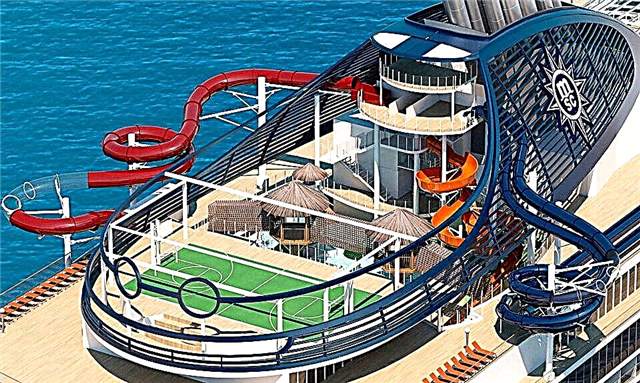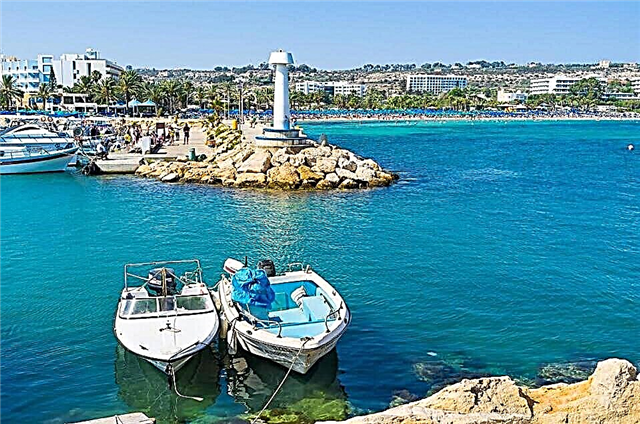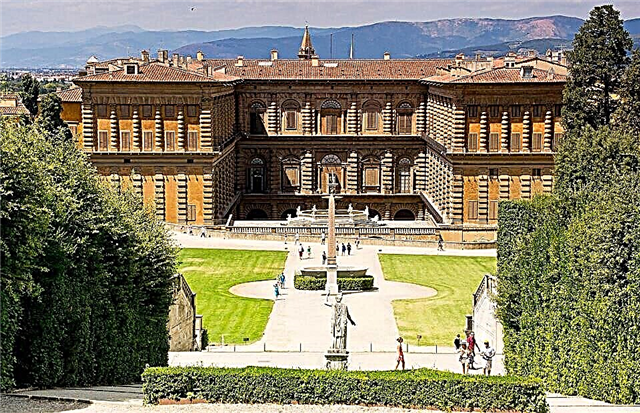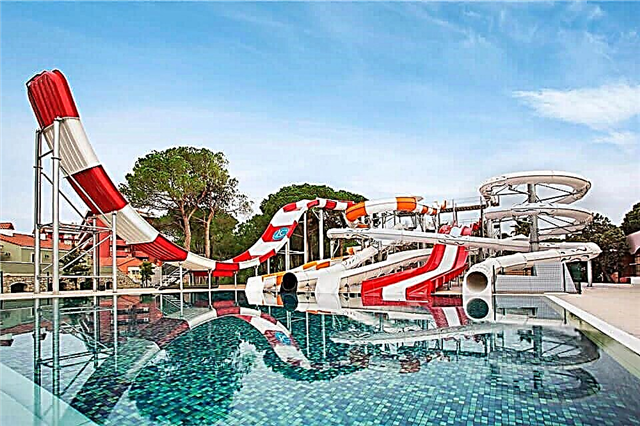For more than 400 years, Macau was in the status of a Portuguese colony, and only in 1999 was it returned to China. This fact has left an imprint on the lifestyle and architecture of the coastal region. Until now, European and Asian languages, religions and cultural traditions coexist very harmoniously here. And the monuments of Christian culture are adjacent to ancient Chinese temples. The entire historic center of Macau is a living testament to the integration of East and West - on the UNESCO World Heritage List.
Another feature of Macau is the presence of a large number of nightclubs, gambling houses, luxury casinos and ultra-modern entertainment venues. To date, the city has already conquered the leadership of the American Las Vegas, striking its visitors with its Asian scale and dazzling luxury.

The best hotels and hotels at affordable prices.
from 500 rubles / day
What to see and where to go in Macau?
The most interesting and beautiful places for walking. Photos and a short description.
Senado Square
The heart of historic Macau. Any journey around the city begins from here. The main objects are fountains, benches and green alleys, cafes and shops, black and white paving stones with a wavy pattern. As well as magnificent buildings from the colonial era, showcasing the multicultural spirit of Macau. Among the most famous are the Church of St. Dominic, the House of Mercy, the former Senate, the Chinese temple, the Church of Our Lady, etc. National holidays, fairs and festivals are held on the square.

Ruins of st paul cathedral
Remains of the once majestic, largest in Asia, Catholic temple - the main symbol of Macau. The flow of tourists does not dry up to it. It is under the protection of UNESCO. All that remains of it after the fire of 1835 is a lonely wall, or rather a facade with sculptural compositions, to which a monumental staircase leads. On the site of the former altar, there is an underground chapel with the surviving relics of Christian martyrs. A museum of sacred art is open nearby.

Coloan village
A small picturesque settlement in the south of Coloan Island, which has retained the charm of the past. The center of the village is occupied by the Eduard Markes square, paved with multi-colored stones in the form of waves. The main attraction of these places is the Francis Xavier chapel. Other interesting objects include 7 Chinese ancient temples, an old library, a Buddhist cemetery on the side of a mountain, an embankment, many shops, restaurants and coffee houses, excellent beaches.

Giant Panda Pavilion
Located in a park called Seac Pai Van. Occupies an area of 3000 m2... All buildings of the pavilion organically fit into the natural landscape. There are covered panda enclosures, food preparation rooms, branch cabinet, and a large courtyard. There are two paths for visitors. Considering that pandas love to sleep, it is better to come to the pavilion in the morning. In the park there are aviaries with other animals, a gift shop, a cafe, an information center.

Macau tower
It opened in 2001. Has a height of 338 meters and 61 floors. It is a huge complex consisting of shops, restaurants, cafes, exhibition centers, a cinema. The observation deck is located at a height of 233 meters, consists of two levels, and has a glass moving floor. The tower is listed in the Guinness Book as the highest area for bungee jumping. Also, fans of extreme sports are invited to climb the spire of a skyscraper and climb the outer walls.

Fort Guia
Defensive fortress of the early 17th century. It rises on the Guia hill - the highest point of the peninsula. Simultaneously with the fort, a chapel was being built, which is famous for its frescoes. It was designed by the monks of the Order of Saint Clara. In 1864, a 15-meter European-style lighthouse was built nearby - the first on the Chinese coast. There is an observation deck at its top. The Maritime Museum is open in the fortress. You can climb the hill by cable car.

Fort Monte
It was built at the beginning of the 17th century to protect against attacks from the sea. Built by the Portuguese authorities with the support of the Jesuit Order. Located at the top of a hill, it has a quadrangular shape. All corners are covered with bastions. The walls facing the sea are equipped with loopholes with ancient guns and towers. Inside the fort, the premises of warehouses, soldiers' barracks, and an arsenal have been preserved. There is a square between them. An observation deck is equipped. There is a museum nearby.

Macau Museum
It was opened in 1998 on the territory of Fort Monte, in a building of the 17th century that belonged to a weather station. The expositions are located on 3 levels - two underground and one aboveground. They are dedicated to the history of Macau, the Portuguese influence on the development of the region, traditions, folk crafts and everyday life of local residents, as well as the peculiarities of modern urban life. Among the exhibits are an ancient printing press and tape measure, old cards, famous Chinese shadow dolls, sculptures, etc.

"Mandarin House"
A city manor that belonged to the family of Chinese official Zheng Guanyin. It was built in 1869. Occupies an area of 4000 m2... Built in Chinese traditions, but using elements of Western cultures. Consists of several living quarters, surrounded by a fence. Outside, the residence is decorated with round doors and arches, latticed windows, ornaments on the walls. Furniture, books, decor items have been preserved inside. A museum has been opened here since 2001. Free admission.

Macau Science Center
The opening date is 2009. It is a futuristic cone-shaped building with no floors inside, and all galleries are located in a spiral. Each of them is dedicated to a different topic - planet Earth and natural phenomena, various technologies, robotics, cooking, scientists and discoveries, etc. The building has an observation gallery with excellent views of the sea and the surrounding area. A planetarium was built nearby, where films in 3D format are shown on a 15-meter screen.

Taipa houses-museums
Five villas of beautiful jade color that belonged to members of the Portuguese administration, respected people of the city. Built in the early 1920s. The interior features a combination of Chinese and Portuguese styles. Today the houses have been reconstructed and turned into exhibition halls, where collections of ceramics, sculptures, national costumes, photographs, household items, paintings are presented. One of the houses is intended for receptions, banquets, cultural events.

Museum Grand Prix
Dedicated to Formula 3 car racing. The first tournament took place in Macau in 1954. Since then, the competition has been held annually in the month of November. The museum opened in 1993. Its creation was initiated by a local entrepreneur who participated in the races - Teddy Yipp. The museum displays cars and motorcycles of famous pilots, a model of a race track, photographs of champions, cups, videos from competitions of different years. Admission is free for everyone.

Maritime museum
The building of the museum in the form of a white sailing ship was built on the very place where the Portuguese landed in 1553 - on the hill of Bara. Has been welcoming visitors since 1990. Contains 4 exhibitions on the history of the maritime affairs of Portugal, China and Macau. Here you can learn about the life and life of local fishermen, discoveries of Portuguese pioneers, the history of trade relations, modern shipping. Models of fishing gear, ships, junk boats, fishing vessels, etc. are presented.

Macau Museum of Art
The modern building of the museum covers an area of 10 thousand m2, has 5 floors and consists of 7 exhibition galleries. They contain valuable collections of Chinese painting, calligraphy and ceramics, historical paintings, European engravings of local landscapes, and contemporary art.It also hosts temporary exhibitions of artwork by Chinese and foreign authors. The building has an auditorium for 100 seats, a library, and various workshops.

Temple of a-ma
It was erected in the XIV century in honor of the patroness of seafarers and fishermen - the goddess A-Ma. Located on a hillside. It is made in the Chinese style with small towers, the roofs of which are turned up. Consists of several pavilions and prayer halls. The square in front of the temple is paved with colorful cobblestones brought from Portugal. They form a pattern that resembles waves. Services are held in the temple today, the cult of the sea goddess A-Ma is revered.

Church of St. Dominic
It was built at the end of the 16th century by Spanish monks. The main material was wood. Later, in 1828, it was reconstructed from stone. Made in the Baroque style using European and local design features. The interior is richly decorated with paintings, carvings, mirrors, sculptures. The bell tower is famous for the oldest bronze bells in the city. A museum is open here, where about 300 unique artifacts and works of religious art are kept.

Macau Cathedral
It was built at the beginning of the 17th century. Subsequently, it was reconstructed several times, the last time - in 1937, when the building was rebuilt from concrete. The facade is finished with Shanghai stucco, which gives the cathedral a monolithic, austere and slightly austere look, complemented by pilasters and two symmetrical towers. Before the transfer of Macau to China, it was here that one of the main symbols of power, the scepter, was kept. The temple is currently operating. The bishop's house is nearby.

Catholic Chapel of Our Lady of Peña
Overlooking the sea on the small hill of Peña. The date of foundation is 1622. It was erected by the Augustinian order for sailors. Made in Romanesque style with Gothic elements. It was rebuilt many times, a bell tower with an original weather vane, a staircase and an arcade were added. In the courtyard, there are two sculptures of the Mother of God. There is a garden with fountains, a recreation area, a playground. A popular place for wedding photo shoots.

Church of St. Lawrence
It was originally erected by the Jesuits in the middle of the 16th century from wood. It acquired its modern look in 1846. It has the shape of a Latin cross. On the sides there are two chapels. Made in neoclassical style with decorative baroque elements. The windows are decorated with stained-glass windows with scenes from the lives of the saints. It is currently the main church of one of the parishes in Macau. In the garden near the temple, a series of three-dimensional drawings on the theme of biblical subjects are exhibited.

Chapel of Saint Francis Xavier
It appeared in 1928 on the southern coast of Coloan Island, near the monument in honor of the Portuguese victory over pirates in 1910. Used to store especially revered Christian relics. Among them are fragments of the bones of Francis Xavier. And also the remains of Catholic priests crucified in 1597 in Nagasaki, and Japanese Christians who died in 1637 during the uprising in Shimabara. At the end of the 20th century, the relics were moved to the museum and other temples.

The venetian
An entire city block under one roof - a hotel, 350 shops, a cinema and concert hall with 15,000 seats, 30 world-class restaurants, a conference hall, a gaming facility with 850 tables and 4,000 slot machines. Fountains, statues, squares, bridges and real canals, along which gondolas glide, are built under the "Venetian sky" painted by Italian artists. The gondoliers are the best opera singers. It is the largest structure in Asia and the second largest in the world.

Grand lisboa
Renovated in 2007, Macau's oldest casino has taken on a new modern look. Made in the shape of a lotus flower. Shines with gold during the day, shimmers with bright lights and spotlights at night. The interior is created in Chinese style, luxuriously decorated, lots of ivory and gold decorations. The building has 57 floors, with playrooms on the upper levels. There are separate rooms for experienced players. The casino contains one of the largest diamonds in the world - 218.08 carats.

Galaxy Macau
A grandiose entertainment complex, one of the largest in the world. Includes 3 hotels, over 50 bars and restaurants, 6 pools, beach, tropical gardens, 600-table games room, etc. It is famous for its huge rooftop pool, where artificial waves are created and even windsurfing competitions are held. Another attraction of the complex is the Diamond Fountain. Every evening a huge diamond rises from it, accompanied by music and visual effects.

City of dreams
The City of Dreams shining with lights includes 3 hotels, fashion boutiques, one of the most famous nightclubs in Asia - Cubic, a two-level casino with 450 gaming tables, about 20 restaurants and bars. Also City of Dreams is widely famous for two theaters - "The Bubble" and "Dancing Water Theater". Their performances are vibrant water shows with great sound and light special effects. The entertainment complex was built in 2009. It is located in the Kotai area.

"House of Dancing Water"
An enchanting show program, for which an auditorium for 2000 seats was built with an unusual stage that turns into a huge pool. The most impressive sight in the world, the cost of which exceeded $ 250 million. The show involves 80 acrobats, 30 divers, 150 technicians. A colorful production based on European and Chinese stories, filled with acrobatic and underwater performances, bright dances, motorcycle stunts, special effects and animated graphics.












